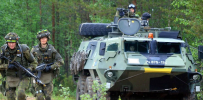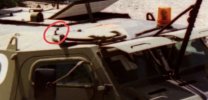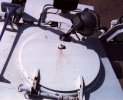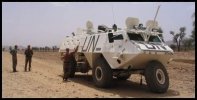Onpas niillä kiire korvata Rosomak, vaikka eivät ole päässeet vielä ykkös-Bemareistakaan eroon??? Rosomakit kuitenkin tilattiin ensimmäisen kerran 2002 ja polonisaatiossakin varmaan meni aikaa muutama vuosi ennen kuin päästiin rakentamaan sarjavaunuja...
Puolan hankintapolitiikka on ollut vähintäänkin poukkoilevaa kylmän sodan päättymisen jälkeen, joten ehkä tämäkin kiire muuttuu vielä tarpeeksi pitää Rosomakit rivissä.
Varsinkin jos seuraajasta ei saada tehtyä päätöstä tai jos sen valmistus onkin hitaampaa kuin suunniteltiin. Tai jos kaikki muut hankinnat syövät budjettia niin paljon, ettei rahaa riitä uusien pyöräajoneuvojen hankintaan.
-
Lähdin etsimään lisätietoa eri varianttien määristä, tässä voisi olla hyvä lista. Puolalaiselta sivulta, alla pätkä pidemmästä artikkelista (julkaistu 23.3.2020):
LÄHDE
As a result of the first contract of April 15, 2003, worth about PLN 4.6 billion, 570
Rosomak APCs were produced , including 359 in the combat version (IFV) with the HITFIST-30P turret and 211 in the basic version and specialized, including:
- 27 pieces in the Rosomak-S version adapted to carry Spike-LR anti-tank guided missiles (ATGMs);
- 33 pcs. Rosomak-WEM (Medical Evacuation Vehicle);
- 4 pcs. in Rosomak-NJ version (Driving School);
- 2 pcs. in the Rosomak-WSRiD version adapted for reconnaissance and surveillance using the Multi-sensor Recognition and Surveillance System;
- 31 pcs. in the Rosomak-M3 version equipped with OSS-D turntables (Large Armored Shooting Station);
- 114 units in the base version (or other versions that were later reverted to the base version).
The above estimates may slightly complicate the losses incurred by the Polish Armed Forces in Afghanistan. A few KTO
Rosomak were irretrievably lost there . Information about 14 copies can be found in the media. In what versions these cars were, unfortunately, the author was unable to determine.
In 2013, another 307 vehicles in the basic version were ordered, however, as already mentioned, as a result of the signed annexes, the scope of the contract was probably reduced by 9 vehicles to the level of 298 vehicles. In the years 2013-2020, the army received (or will receive) approx. 412 vehicles in the basic version (minus the vehicles lost in Afghanistan). On the basis of contracts already signed (or being negotiated), the following specialized versions of the
Rosomak APC have been or will be developed with the use of these chassis :
- 82 M120K Rak self-propelled mortars , which are part of the ordered 10 Company Fire Modules (KMO) Rak , of which 64 have already been delivered by the end of 2019 (for 8 HMGs);
- 40 Artillery Command Vehicles (AWD), which are part of the ordered 10 Rak HMGs , of which 32 have already been delivered by the end of 2019 (for 8 HMGs);
- 20 Artillery Reconnaissance Vehicles (AWR), which are to be part of the Rak KMO , and their orders can be expected at the turn of 2020 and 2021, after the prototype tests are completed;
- 33 Technical Reconnaissance Vehicles (WRT), manufactured and delivered in 2016-2017;
- 18 Technical Assistance Vehicles (WPT), which are to be manufactured and delivered by 2025, while in 2020, as part of the ongoing development work, the works related to the development of the prototype are to be completed;
- 11 Contamination Recognition Vehicles (RSK), the development and production of which is currently underway by the Armament Inspectorate.
In total, 204 base chassis have been (or will be) used for the above-mentioned specialized versions of the
Rosomak APC. Therefore, up to 208 units will remain at the disposal of the army.
This is exactly as much as planned for the installation of unmanned ZSSW-30 turrets. It was intended to use it to produce 180 APC
Rosomak in the combat version, 9 pcs in the R-1 Command and Reconnaissance Vehicles version and 19 pcs in the R-2 Reconnaissance Vehicles version.
In addition, the R-1 Command and Reconnaissance Vehicles and the R-2 Reconnaissance Vehicles are to be built as a result of the conversion of already produced combat vehicles with the HITFIST-30P turret, 16 and 34 units, respectively.
The plans of the Land Forces also included the development and production of anti-aircraft command vehicles of the Łowcza anti-aircraft squadron level (a total of 3 units, one for each of the brigades equipped with the Rosomak APC) and the Rega anti-aircraft battery level (a total of 9 units, three
for each brigade). . They can arise, for example, as a result of the reconstruction of the vehicles that are currently in the Rosomak M3 version with a turntable.
The Land Forces also need Wheeled Engineering Transporters (KTI) kr.
Fir . We are talking about three versions of the vehicles: the Wheeled Engineering Reconnaissance Transporter (KTRI), the Wheeled Engineering Support Transporter (KTWI) and the Wheeled Engineering Transporter EOD (Explosive Ordnance Disposal), designed for soldiers dealing with the neutralization of unexploded ordnance and improvised explosive devices (KTI-EOD). The total demand for this type of vehicles can be estimated at about 100 units.
Until recently, the needs of the Land Forces regarding the
Rosomak APC were defined as 8 motorized infantry battalions, including 3 battalions each in the 17th Mechanized Brigade and 12th Mechanized Brigade, and 2 battalions in the 21st Podhale Rifle Brigade. Also, the number of combat and specialized versions of the Wolverines ordered was adjusted to the given number of battalions. Meanwhile, after the formation of the 18th Mechanized Division has begun, the 21st Podhale Rifle Brigade, which is part of it, will ultimately consist of four infantry battalions armed with the
Rosomak APC . This means that the target number of battalions armed with this type of vehicle may increase from eight to ten.
Eight battalions of motorized infantry need 464 vehicles in the combat version, and 580 vehicles for 10 battalions (excluding supplies and training needs). If the plans related to the production of 208 ZSSW-30 turrets are implemented, the Land Forces will theoretically have up to 489 APCs (including 309 with the HITFIST-30P turret and 180 with the ZSSW-30 turret) and 78 of R-1/R-2 vehicles (including 50 units with the HITFIST-30P turret and 28 units with the ZSSW-30 turret). In reality, it will be a few pieces less, due to the losses incurred in Afghanistan. Regardless, however, these quantities will be sufficient for 8 battalions, but too small for 10 battalions.
While maintaining the previously planned structure of battalions and brigades and the degree of equipping them with APCs, it may therefore be necessary to produce at least 100 additional Rosomaks in the combat version.




 203:ssa salpa on siellä luukun sisäpuolella. Ainakin johtajan luukussa.
203:ssa salpa on siellä luukun sisäpuolella. Ainakin johtajan luukussa.
 Kostivat prkl
Kostivat prkl 



